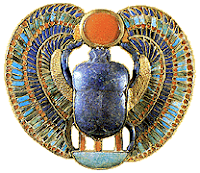When a young French general named Bonaparte invaded Egypt in 1798, it sparked a renewed interest in that country and the beautiful antiquities found there. The styles had already been willing adopted by Europeans since the mid-18th century, but now the French were dealing wholesale. Artifacts and antiquities were carted out and eagerly shipped to anyone who could pay for them. The English happily joined in the mania.
Grand homes throughout the British Isles were adorned with Egyptian stylings, with architecture, fabrics and prints based on designs found in ancient tombs and with artifacts of all kinds. Thanks to designers such as Thomas Hope, luxurious Egypt-themed furnishings were becoming commonplace. Of course demand was high, too, for the real stuff. Once the French were defeated in 1801 and the English took over their Egyptian interests, the plunder persisted. English homes continued to benefit from the beauties of all things Egyptian.
The pasha of Egypt at the time, Muhammad Ali, found he could win favor and political advance by helping keep the English well supplied with mummies, carvings, jewelry and all manner of things dug up from the sand. The impression today is that most Egyptians of that time were all too happy to profit from the legal--and illegal--trade in these artifacts. The various sects and cultural groups within the Egyptian population often used the trade in antiquities for their own political purposes and personal gain. Sadly, it was not until many years later when the people of Egypt began to recognize the historical importance of these treasures left behind by their forbearers.
During Jane Austen's lifetime she would no doubt have seen many of these Egyptian stylings and influences. She likely noticed ladies dressed in Egyptian silk trimmed with elaborate Arabesque designs. She could have visited the initial collection of Egyptian artifacts established within the British Museum. These were primarily spoils of war taken from the French and included the still un-translated Rosetta Stone. She might have paid little mind to them all, though, as she writes to her sister that she visited the museum, but "my preference for men and women always inclines me to attend more to the company than the sight..."
~~~
Susan Gee Heino writes Regency-set historicals for Berkley Sensation. Her latest release, PASSION AND PRETENSE, features an Egypt-obsessed heroine, a very special scarab necklace, and an even more special gentleman-rogue who is determined to steal it from her.Visit Ms. Heino's website at www.SusanGH.com.





I love Egyptian
ReplyDeletejewelry . It's so colorful, and yet somehow those colors have made it through thousands of years!
I love the colors, too. They're so vibrant, yet so natural. Amazing to think that they've survived so long and we can appreciate them today.
ReplyDeleteThanks for inviting me to guest blog with you, Lesley-Anne. I love all the fascinating topics you cover here!
Susan Gee Heino
Great topic, Susan!
ReplyDeleteI love the jewelry too, and the beautiful classical clothing styles. I always assumed Europeans were so limited to their own culture, so it's cool to imagine all those intrepid explorers learning about other parts of the world.
What a terrific topic! I loved the painting with all the gorgeous clothes. I'm incorporating Egypt into my current WIP (although it's Victorian era), simply because I think our fascination with beautiful Egyptian artifacts persists still today.
ReplyDeleteVery interesting topic. I had always assumed without knowing that the strong English interest in Egypt started a little later in Victorian colonial times, but now I have some "learnin" to correct my assumptions. Thanks, Susan. Gorgeous pictures, BTW.
ReplyDeleteLibby
Hi, Susan! Like Libby, I was surprised to hear that England's rage for all things Egyptian came as early as it did. I associate England's Egyptian interest with Victorian times. I'm glad to now have more decorative ammunition to add to my Regency novel. Thanks for the post!
ReplyDelete